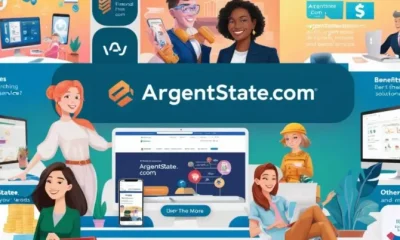News
PonderShort: A Comprehensive Guide with FAQs
Published
9 months agoon
By
Henry
The digital landscape is continually evolving, and with it, the ways in which we communicate and consume content. One of the latest innovations is PonderShort, a platform designed to offer concise, easily digestible content to busy individuals. As attention spans decrease and the need for quick, yet informative content increases, Ponder-Short fills the gap between traditional long-form content and the rapid-fire, often shallow, nature of social media.
In this article, we’ll explore what Ponder-Short is, how it works, and why it’s becoming a preferred medium for many content creators and consumers. We’ll also tackle some frequently asked questions (FAQs) to help you better understand its purpose and functionality.

What is PonderShort?
Ponder-Short is a content platform that allows creators to share brief, thought-provoking pieces of writing. Typically, these are limited to a few hundred words, which is shorter than traditional blog posts but longer than a tweet. The core idea behind Ponder-Short is to encourage brevity while maintaining depth, offering insights in a format that is both engaging and easy to consume.
The platform caters to individuals who want to express their ideas without the pressure of crafting long essays or articles. It’s also a favorite for readers who seek quick, impactful reads during their limited free time.
The rise of Ponder-Short parallels the increasing demand for “snackable content” — pieces of information that can be consumed quickly but still leave a lasting impression.
Features of PonderShort
- Concise Format: Ponder-Short focuses on brevity. Each post is designed to be a bite-sized piece of content, typically ranging between 100-500 words. This makes it ideal for readers who want to engage with insightful content but are limited on time.
- Focus on Thought-Provoking Content: Unlike other platforms that might prioritize entertainment or shallow commentary, Ponder-Short encourages deep, reflective thinking. It’s a space where ideas, not just information, thrive. Topics range from philosophy, technology, science, and literature to personal growth and societal issues.
- Community Engagement: Readers can engage with authors through likes, comments, and sharing. However, the interaction is designed to be meaningful rather than purely social, creating a focused environment for intellectual exchange.
- Curation: Ponder-Short uses algorithms to curate content based on user preferences and reading history, making it easier to find pieces that align with your interests. The curation model ensures that users are exposed to diverse, thoughtful perspectives.
- Monetization for Creators: Content creators can monetize their work through a subscription model or one-time payments, allowing them to be compensated for their intellectual contributions without relying on ads or sponsored content.
How Does PonderShort Work?
Ponder-Short operates through a simple, user-friendly interface. Creators sign up for an account, after which they can begin posting content within the word-limit restrictions. Once a piece is published, it becomes visible to the platform’s audience based on their interests and reading habits.
Ponder-Short employs a unique recommendation algorithm that emphasizes quality over quantity. This means that instead of pushing the most recent content or the posts with the most likes, it prioritizes thoughtful engagement and relevance.
As a reader, you can follow your favorite writers, like and comment on posts, and share them with others. The platform also offers features such as bookmarks to save content for later reading and subscriptions to get regular updates from specific creators.
Why is PonderShort Gaining Popularity?
- Attention Economy: In the digital age, attention is a valuable currency. People are bombarded with information from all sides—news articles, social media posts, emails, videos, and podcasts. The amount of available content can be overwhelming. PonderShort’s format caters to this “attention economy” by offering meaningful content in a concise format. It respects the reader’s time while still providing intellectual value.
- Accessibility: PonderShort is a highly accessible platform for both creators and readers. For writers, it reduces the burden of creating long-form content, which can be daunting or time-consuming. For readers, it’s an easy way to engage with new ideas without the time commitment often required by longer articles or essays.
- Diverse Perspectives: PonderShort democratizes content creation by giving a platform to voices that might not have a space in traditional media. Because the posts are brief and the barrier to entry is low, people from all walks of life can share their insights and stories, enriching the platform’s diversity of ideas.
- Quality Over Quantity: In contrast to many social media platforms that reward viral content regardless of its depth or accuracy, PonderShort’s emphasis is on the quality of ideas. The platform encourages thoughtful engagement over fleeting interactions, making it a go-to space for intellectual discourse.
FAQs about PonderShort
Q1: How is PonderShort different from other platforms like Twitter or Medium?
A: PonderShort occupies a unique space between the brevity of Twitter and the longer formats found on platforms like Medium. While Twitter is geared towards real-time updates and quick interactions, PonderShort allows for more in-depth reflection without requiring the length of a traditional blog post. Medium, on the other hand, focuses on long-form content, whereas PonderShort emphasizes brevity while maintaining depth.
Q2: Is PonderShort free to use?
A: Yes, PonderShort is free to use for both readers and writers. However, there are premium features such as subscribing to exclusive content from certain creators or supporting them with one-time payments. This offers a revenue model for writers while keeping the core platform accessible to all users.
Q3: What kinds of content are best suited for PonderShort?
A: PonderShort is ideal for any content that requires thoughtful engagement but can be expressed in a few hundred words. This includes personal reflections, philosophical musings, concise analyses of current events, and more. It is not suited for purely visual content or content that requires extensive multimedia integration.
Q4: How does PonderShort ensure the quality of its content?
A: PonderShort uses a combination of algorithmic recommendations and community moderation to maintain the quality of content on the platform. Content that sparks thoughtful discussion or is highly rated by readers is more likely to be promoted. The platform also encourages meaningful interactions over surface-level engagement.
Q5: Can I make money on PonderShort?
A: Yes, creators can monetize their work on PonderShort through various mechanisms such as paid subscriptions or one-time tips from readers. This allows writers to be compensated for their intellectual labor without relying on ads, which can compromise the integrity of content.
Q6: How does PonderShort handle content moderation?
A: PonderShort employs a community-based moderation system where users can flag content that violates platform guidelines. Additionally, there are automated tools to detect spam or inappropriate content. However, the emphasis is on fostering an environment of respect and intellectual exchange, so moderation tends to focus on maintaining the quality of discussions.
Q7: Can I use PonderShort to promote my blog or other content?
A: While PonderShort is not designed primarily as a promotional tool, it can certainly complement other content platforms. Writers can use PonderShort to share condensed versions of their larger works or offer unique insights that direct readers to their blog or other platforms. However, overt self-promotion may not resonate well with the platform’s audience, which values thoughtful content.
Q8: Is PonderShort mobile-friendly?
A: Yes, PonderShort is designed to be mobile-friendly, allowing users to read and write posts on the go. The platform’s concise format makes it particularly well-suited for mobile devices, enabling users to consume content in short bursts throughout their day.
Q9: Can I republish content from PonderShort elsewhere?
A: PonderShort generally allows users to republish their content on other platforms, but it’s always a good idea to check the specific terms of service or any agreements related to monetized content. Some creators may choose to keep their content exclusive to PonderShort, especially if they have paying subscribers.
Q10: Is there a character or word limit for posts?
A: Yes, PonderShort encourages brevity, and posts are typically limited to 500 words or fewer. This word limit helps ensure that content remains concise and focused while still allowing room for thoughtful expression.
Conclusion
PonderShort is an innovative platform that addresses the needs of both content creators and readers in today’s fast-paced world. By offering concise, thought-provoking content, it provides an alternative to the overwhelming stream of information found on traditional social media and the lengthy, time-consuming articles on other blogging platforms.
With its emphasis on quality over quantity, PonderShort is becoming a go-to platform for those seeking intellectual engagement in a format that respects their time. Whether you’re a writer looking for a new medium to share your ideas or a reader in search of insightful content, PonderShort offers a unique and valuable experience.
As the platform grows, it’s likely to become an even more significant player in the digital content landscape, helping to bridge the gap between the brevity of social media and the depth of traditional blogs.
You may like
News
Portland State Electrician Leroy: A Trusted Name in Electrical Services
Published
5 months agoon
February 5, 2025By
Harry
In the bustling city of Portland, Oregon, where innovation meets sustainability, the demand for skilled electricians is ever-growing. Among the many professionals in the field, one name stands out for its reliability, expertise, and commitment to quality service: Leroy, a seasoned electrician serving the Portland State community.Portland State Electrician Leroy Whether you’re a homeowner, a business owner, or a property manager, Leroy has built a reputation as the go-to electrician for all your electrical needs.Portland State Electrician Leroy This article delves into Leroy’s story, his services, and answers some frequently asked questions about his work.
Who is Leroy?
Leroy is a licensed and certified electrician with over 15 years of experience in the electrical industry.Portland State Electrician Leroy Based in Portland, Oregon, he has dedicated his career to providing top-notch electrical services to residential, commercial, and industrial clients.Portland State Electrician Leroy Known for his attention to detail, professionalism, and friendly demeanor, Leroy has become a trusted name in the Portland State area.
Leroy’s journey into the electrical trade began at a young age.Portland State Electrician Leroy Growing up in a family of tradespeople, he developed a passion for working with his hands and solving complex problems.Portland State Electrician Leroy After completing his apprenticeship and earning his electrical license, Leroy decided to start his own business, focusing on serving the local community.Portland State Electrician Leroy Over the years, he has built a loyal customer base by consistently delivering high-quality work and prioritizing customer satisfaction.
Services Offered by Leroy
Leroy offers a wide range of electrical services to meet the diverse needs of his clients.Portland State Electrician Leroy Some of his key services include:
- Residential Electrical Services
- Wiring and rewiring for homes
- Electrical panel upgrades
- Lighting installation and repair
- Outlet and switch installation
- Ceiling fan installation
- Home safety inspections
- Commercial Electrical Services
- Office wiring and electrical system design
- Lighting solutions for businesses
- Electrical maintenance and repairs
- Energy-efficient upgrades
- Emergency electrical services
- Industrial Electrical Services
- Machinery wiring and maintenance
- Power distribution systems
- Motor controls and automation
- Safety compliance inspections
- Specialized Services
- Smart home technology installation
- Solar panel wiring and integration
- Electric vehicle (EV) charger installation
- Generator installation and maintenance
Leroy takes pride in staying up-to-date with the latest advancements in the electrical industry. He is well-versed in energy-efficient technologies and sustainable practices, making him a valuable resource for clients looking to reduce their carbon footprint.
Why Choose Leroy?
- Experience and Expertise
With over a decade of experience, Leroy has encountered and resolved a wide variety of electrical issues. His expertise ensures that every job is completed safely and efficiently. - Customer-Centric Approach
Leroy believes in putting his clients first. He takes the time to understand their needs, answer their questions, and provide tailored solutions that fit their budget and timeline. - Reliability and Punctuality
Leroy understands the importance of timely service. Whether it’s a routine inspection or an emergency repair, he arrives on time and gets the job done right. - Transparent Pricing
Leroy provides clear and upfront pricing for all his services. There are no hidden fees or surprises, ensuring peace of mind for his clients. - Commitment to Safety
Electrical work can be dangerous if not handled properly. Leroy adheres to strict safety standards and follows all local codes and regulations to ensure the safety of his clients and their properties.
FAQs About Leroy’s Electrical Services
1. How do I know if I need an electrician?
If you’re experiencing frequent electrical issues such as flickering lights, tripped breakers, or outlets that don’t work, it’s time to call an electrician.Portland State Electrician Leroy Additionally, if you’re planning a renovation, installing new appliances, or upgrading your electrical system, a professional like Leroy can ensure the job is done safely and correctly.
2. Is Leroy licensed and insured?
Yes, Leroy is a fully licensed and insured electrician.Portland State Electrician Leroy He holds all the necessary certifications to perform electrical work in Portland and the surrounding areas. His insurance coverage protects both him and his clients in the event of an accident or damage.
3. What areas does Leroy serve?
Leroy primarily serves the Portland State area, including downtown Portland, surrounding neighborhoods, and nearby suburbs.Portland State Electrician Leroy If you’re unsure whether he covers your location, feel free to reach out and ask.
4. How much does it cost to hire Leroy?
The cost of Leroy’s services depends on the scope of the project.Portland State Electrician Leroy Simple tasks like outlet repairs or light fixture installations may cost less, while larger projects like panel upgrades or rewiring will be more expensive.Portland State Electrician Leroy Leroy provides free estimates, so you’ll know the cost before any work begins.
5. Can Leroy help with emergency electrical issues?
Absolutely! Leroy offers 24/7 emergency electrical services for situations like power outages, sparking outlets, or electrical fires. He understands that electrical emergencies can happen at any time, and he’s always ready to respond quickly.
6. Does Leroy offer energy-efficient solutions?
Yes, Leroy is passionate about helping clients reduce their energy consumption and lower their utility bills. He can install energy-efficient lighting, smart thermostats, and solar panels, as well as provide advice on other ways to make your home or business more sustainable.
7. How long does it take to complete an electrical project?
The timeline for an electrical project varies depending on its complexity. Simple repairs or installations may take just a few hours, while larger projects like rewiring or panel upgrades could take a day or more. Leroy will provide an estimated timeline during the initial consultation.
8. What should I do before the electrician arrives?
To prepare for Leroy’s visit, make sure the work area is clear and accessible. If you have any specific concerns or questions, write them down so you don’t forget to discuss them. Additionally, locate your electrical panel in case Leroy needs to access it.
9. Can Leroy help with permits and inspections?
Yes, Leroy is familiar with the permitting process and can help you obtain the necessary permits for your project. He also ensures that all work meets local building codes and can assist with inspections if required.
10. How can I schedule an appointment with Leroy?
Scheduling an appointment with Leroy is easy! You can call his office directly, send an email, or fill out the contact form on his website. His team will get back to you promptly to confirm your appointment.
Testimonials from Satisfied Clients
Here’s what some of Leroy’s clients have to say about his work:
- “Leroy is amazing! He fixed our faulty wiring in no time and explained everything in a way we could understand. Highly recommend him!” – Sarah T.
- “We needed an EV charger installed, and Leroy did a fantastic job. He was professional, efficient, and very knowledgeable.” – Mark R.
- “I’ve used Leroy for multiple projects, and he never disappoints. His prices are fair, and his work is top-notch.” – Linda P.
Conclusion
When it comes to electrical services in the Portland State area, Leroy is a name you can trust. His combination of experience, expertise, and customer-focused approach sets him apart from the competition. Whether you’re dealing with a minor electrical issue or planning a major upgrade, Leroy has the skills and knowledge to get the job done right.
If you’re in need of an electrician, don’t hesitate to reach out to Leroy. With his commitment to quality and safety, you can rest assured that your electrical needs are in good hands.
News
5StarsStocks.com: Nickel Investment and Insights
Published
5 months agoon
January 29, 2025By
Harry
In recent years, investors have been drawn to the world of commodities, with many turning their attention toward metals like gold, silver, and copper. However, one metal that has seen significant growth in both demand and price is nickel. With its crucial role in industries such as electric vehicle (EV) manufacturing and renewable energy, nickel has become an increasingly attractive investment opportunity. One platform that has been at the forefront of providing insights into such investments is 5StarsStocks.com.
This article will explore the role of nickel in the global economy, its rising importance in various industries, and why it has caught the eye of investors on platforms like 5StarsStocks.com. Additionally, we will cover frequently asked questions about investing in nickel, addressing the most common inquiries surrounding this investment vehicle.
1. What Is Nickel and Why Is It Important?
Nickel is a silvery-white, malleable metal that is primarily used in the production of alloys, batteries, and other industrial applications. It’s best known for its role in creating stainless steel, where it provides corrosion resistance and improves the strength and durability of the material. Over the years, the global demand for nickel has risen due to its application in various industrial sectors, but it’s particularly in the field of renewable energy and electric vehicles that nickel’s value has skyrocketed.
Nickel is essential in the production of lithium-ion batteries, which are critical components of electric vehicles and energy storage systems. As governments and industries work toward transitioning to cleaner, more sustainable energy sources, the demand for nickel—especially the higher-grade variants used in EV batteries—is expected to continue rising. This creates an attractive investment landscape for those seeking to capitalize on the growing green energy movement.
2. The Role of 5StarsStocks.com in Nickel Investment
5StarsStocks.com is a platform designed to provide investors with real-time stock analysis, insights, and recommendations across a wide range of industries, including mining and commodities. For investors specifically interested in nickel, 5StarsStocks.com provides valuable resources, including detailed reports on nickel mining companies, market trends, and potential investment opportunities.
Through 5StarsStocks.com, users can access expert analysis on nickel stocks and understand the factors that could affect the price of nickel in the future. For example, geopolitical events, supply chain disruptions, and technological advancements in battery production all play a role in nickel prices. By staying informed through this platform, investors can make data-driven decisions to optimize their portfolios and seize emerging opportunities in the nickel market.
3. Why Is Nickel Such a Valuable Metal Right Now?
There are several reasons why nickel is garnering significant attention from investors. These include:
a. Demand from Electric Vehicles
As the world moves towards a more sustainable future, the electric vehicle (EV) market has experienced exponential growth. Nickel plays a vital role in the development of lithium-ion batteries, which are the most common power source for EVs. The demand for EVs is expected to increase dramatically in the coming years, fueled by both consumer preference and government policies that push for cleaner transportation alternatives.
Nickel’s role in batteries has led to a surge in demand, particularly for high-quality nickel suitable for EV battery production. As automakers and battery manufacturers scramble to secure a steady supply of this metal, its value is projected to rise further.
b. Energy Storage and Renewable Energy
Nickel’s importance extends beyond the automotive sector. It is also a crucial component of energy storage systems (ESS) used to store renewable energy from solar and wind power. With the growing need for renewable energy sources to replace fossil fuels, nickel is becoming an increasingly valuable metal. Storage technologies, like nickel-based batteries, help stabilize the energy grid and make renewable power more reliable and accessible.
c. Limited Supply
Nickel is not a metal that is easily sourced in abundance. Major nickel-producing countries include Indonesia, the Philippines, and Russia. However, mining operations are often faced with challenges such as environmental regulations, cost inefficiencies, and geopolitical risks. As a result, the supply of high-quality nickel has struggled to meet the increasing demand, which has contributed to rising prices. In addition, the high costs associated with mining and refining nickel further amplify its scarcity, making it a valuable asset for investors.
d. Industrial Applications
Beyond EVs and energy storage, nickel continues to be in high demand for industrial applications, particularly in the aerospace, military, and construction sectors. As industries look for more durable, heat-resistant materials, the importance of nickel as an alloy increases. Stainless steel, which contains nickel, remains one of the most widely used materials in global manufacturing, making nickel a staple in infrastructure projects.
4. Types of Nickel Investments
There are several ways investors can gain exposure to the nickel market. 5StarsStocks.com offers guidance on the following nickel investment options:
a. Direct Investment in Nickel Stocks
Investing in companies that mine, refine, or produce nickel is one of the most direct ways to gain exposure to the nickel market. These companies are often publicly traded, allowing investors to buy shares and profit from the potential appreciation of nickel prices. Popular nickel mining companies include Vale SA, Norilsk Nickel, and BHP Billiton.
b. Nickel ETFs (Exchange-Traded Funds)
For those looking to diversify their exposure, investing in a nickel-focused ETF could be an attractive option. These funds pool together a variety of nickel-related stocks, offering investors exposure to multiple companies in the sector. Examples of nickel ETFs include the Global X Lithium & Battery Tech ETF and the iPath Series B Bloomberg Nickel Subindex Total Return ETN.
c. Nickel Futures Contracts
Futures contracts are another way to gain exposure to nickel prices. These are legally binding agreements to buy or sell nickel at a specific price on a future date. Futures contracts are typically used by more sophisticated investors who have a solid understanding of the commodities market. While futures trading can be highly profitable, it also carries significant risk.
d. Physical Nickel
Some investors prefer to invest directly in physical nickel, typically through buying bars or coins. While this form of investment may appeal to collectors or those interested in holding a tangible asset, it’s less common for large-scale investors compared to other forms of investment.
5. The Future of Nickel Investment
As the demand for electric vehicles, renewable energy, and advanced technologies continues to grow, the future of nickel as an investment looks promising. However, like all commodities, it is subject to volatility. Factors such as geopolitical events, economic cycles, and changes in environmental regulations can influence nickel prices.
On 5StarsStocks.com, investors can access expert analysis and reports to stay informed about these factors and better understand the potential risks and rewards of nickel investments. By carefully tracking market trends and understanding the underlying supply-demand dynamics, investors can make informed decisions about their nickel portfolios.
FAQs About Investing in Nickel
Q1: What is the best way to invest in nickel?
The best way to invest in nickel depends on your risk tolerance and investment goals. Some prefer to invest in mining companies, while others opt for ETFs or futures contracts. Each option carries its own risks and rewards, and it’s crucial to conduct thorough research or consult a financial advisor before making a decision.
Q2: How does the growth of electric vehicles impact nickel prices?
The growth of electric vehicles has significantly increased the demand for high-quality nickel, as it is a key component in lithium-ion batteries. As the EV market expands, so too does the need for nickel, which in turn drives up its price. The shift towards cleaner transportation options is one of the key factors contributing to nickel’s rising value.
Q3: Are nickel prices expected to continue rising?
Many experts predict that nickel prices will continue to rise, driven by strong demand from industries such as electric vehicles, renewable energy, and industrial manufacturing. However, like all commodities, nickel is subject to price volatility, and unforeseen events can impact the market.
Q4: What are the risks of investing in nickel?
Some of the risks include price volatility, geopolitical risks affecting supply chains, and environmental regulations that can impact mining operations. Additionally, factors like global economic downturns or shifts in demand from key industries can influence nickel prices.
Q5: Can I invest in physical nickel?
Yes, investors can purchase physical nickel, but this is generally less common compared to other investment vehicles. Investing in physical nickel may appeal to collectors or those interested in tangible assets, but it comes with challenges such as storage and security.
Q6: How can 5StarsStocks.com help me with nickel investments?
5StarsStocks.com provides comprehensive reports, market analysis, and expert insights into nickel-related stocks, ETFs, and commodities. The platform can help you stay informed about market trends, helping you make data-driven decisions for your nickel investments.
Conclusion
Nickel is a crucial metal in the modern economy, particularly due to its importance in electric vehicle manufacturing, energy storage, and industrial applications. As demand for nickel continues to rise, it represents a potentially lucrative investment opportunity. Platforms like 5StarsStocks.com can provide valuable insights, analysis, and recommendations to help investors navigate this growing market.
By staying informed about the key factors influencing nickel prices and understanding the different investment options available, investors can position themselves to benefit from the increasing demand for this essential metal.
News
Cursed Memes: A Deep Dive into the Business Behind Cursed-Memes.com
Published
7 months agoon
November 25, 2024By
Harry
In recent years, memes have transformed from simple internet jokes to a significant part of online culture and communication. Among these, cursed memes stand out for their bizarre and unsettling humor. One platform that has capitalized on this trend is Cursed-Memes.com, a website dedicated to curating and sharing these unique creations. In this article, we will explore the concept of cursed-memes, the business model of Cursed-Memes.com, and address frequently asked questions about this intriguing corner of the internet.
Understanding Cursed Memes
What Are Cursed Memes?
Cursed memes are a subgenre of memes characterized by their surreal, disturbing, or nonsensical nature. They often evoke a sense of confusion or discomfort, combining unexpected elements or absurd humor. These memes can range from strange images manipulated in unusual ways to captions that play on dark or bizarre themes. The “cursed” aspect refers to the unsettling feelings they evoke, which can lead to laughter or confusion among viewers.
The Appeal of Cursed Memes
The allure of cursed memes lies in their unpredictability. In a world saturated with typical memes, cursed memes offer a refreshing departure. They challenge conventional humor by embracing the absurd and the bizarre. Additionally, the communal aspect of sharing these memes fosters a sense of belonging among fans, who enjoy discussing and dissecting the strange images and concepts.
Cursed-Memes.com: The Business Model
Origin and Development
Cursed-Memes.com was founded to serve as a dedicated platform for enthusiasts of cursed memes. The site features a user-friendly interface that allows visitors to easily navigate through various categories of cursed content. Since its inception, the website has grown in popularity, attracting a diverse audience eager to engage with this unique form of humor.
Revenue Streams
Cursed-Memes.com employs several revenue-generating strategies to sustain its operations:
- Ad Revenue: The website features advertisements that generate income based on user traffic. By partnering with ad networks, Cursed-Memes.com can monetize the high volume of visitors attracted to its content.
- Merchandise Sales: Cursed-Memes.com has expanded into merchandise, selling products featuring popular cursed memes. Items such as t-shirts, mugs, and stickers allow fans to showcase their love for this niche humor while providing an additional revenue stream.
- Premium Memberships: The site offers premium memberships that provide exclusive content, early access to new memes, and ad-free browsing experiences. This model fosters a sense of community and loyalty among dedicated fans.
- Sponsorships and Partnerships: Cursed-Memes.com collaborates with brands that align with its unique aesthetic, providing sponsored content and promotional campaigns that resonate with its audience.
Community Engagement
A significant aspect of Cursed-Memes.com’s success is its commitment to community engagement. The site features a forum where users can discuss their favorite memes, share their creations, and interact with others who share their interests. This interaction not only fosters a sense of belonging but also encourages users to return regularly, boosting overall site traffic.
The Impact of Cursed Memes on Internet Culture
Cursed memes have made a notable impact on internet culture, influencing how humor is consumed and shared online. They represent a departure from traditional memes, pushing boundaries and redefining comedic expression. Cursed memes often blend elements of horror, surrealism, and absurdity, leading to a more diverse and complex meme landscape.
Cultural Significance
Cursed memes can be seen as a reflection of societal anxieties and fears. By confronting disturbing themes through humor, they offer a coping mechanism for individuals grappling with complex emotions. This unique blend of humor and discomfort resonates with a generation navigating a rapidly changing world, making cursed memes a relevant cultural phenomenon.
Frequently Asked Questions (FAQs)
1. What is a cursed meme?
Answer: A cursed meme is a type of meme characterized by its bizarre, surreal, or disturbing content. These memes often combine unexpected elements or absurd humor, evoking feelings of discomfort or confusion.
2. How did Cursed-Memes.com start?
Answer: Cursed-Memes.com was founded to provide a dedicated platform for enthusiasts of cursed memes. It has since grown in popularity, attracting a diverse audience eager to engage with this unique form of humor.
3. How does Cursed-Memes.com make money?
Answer: The website generates revenue through various streams, including ad revenue, merchandise sales, premium memberships, and sponsorships. These strategies help sustain the site’s operations while providing content to its users.
4. Can I submit my own cursed memes to Cursed-Memes.com?
Answer: Yes, Cursed-Memes.com encourages users to submit their own cursed memes. The site often features user-generated content, allowing the community to contribute to the ever-growing collection of cursed memes.
5. What types of products are available for sale on Cursed-Memes.com?
Answer: Cursed-Memes.com offers a variety of merchandise featuring popular cursed memes, including t-shirts, mugs, stickers, and more. These products allow fans to showcase their love for this niche humor.
6. Is there a community aspect to Cursed-Memes.com?
Answer: Absolutely! Cursed-Memes.com features a forum where users can discuss their favorite memes, share their creations, and interact with others. This sense of community is a key aspect of the site’s appeal.
7. Are there any age restrictions for using Cursed-Memes.com?
Answer: While there are no formal age restrictions, users should be aware that some cursed memes may contain dark or disturbing themes. Parental discretion is advised for younger audiences.
8. How can I stay updated on new content from Cursed-Memes.com?
Answer: Users can subscribe to Cursed-Memes.com’s newsletter or follow their social media accounts to receive updates on new content, promotions, and community events.
9. Can businesses collaborate with Cursed-Memes.com for promotions?
Answer: Yes, Cursed-Memes.com collaborates with brands that align with its unique aesthetic. Businesses interested in partnerships can reach out through the website’s contact page for more information.
10. What makes cursed memes different from regular memes?
Answer: Cursed memes stand out due to their unsettling, surreal, or absurd content. While regular memes often rely on relatable humor, cursed memes embrace the bizarre and challenge conventional comedic norms.
Conclusion
Cursed memes and platforms like Cursed-Memes.com represent a fascinating evolution in the world of internet humor. By embracing the absurd and the uncomfortable, cursed memes have carved out a unique niche within meme culture, attracting a dedicated community of fans. The business model behind Cursed-Memes.com showcases how a passion for unconventional humor can be transformed into a thriving online enterprise, complete with merchandise, community engagement, and innovative revenue streams. As the landscape of internet culture continues to evolve, cursed memes will undoubtedly remain a significant and influential part of the conversation.
Trending
-

 News9 months ago
News9 months agoKaterina Goltzwart: A Multifaceted Talent in the Creative Realm
-

 News9 months ago
News9 months agoAviva Taeidkashani: A Profile of Inspiration and Leadership
-

 Tech9 months ago
Tech9 months agoCrypto Archives on NewzNav: A Deep Dive into the Future of Digital Finance
-

 Life style9 months ago
Life style9 months agoThe Joy of Laughter: A Deep Dive into Its Benefits and Impact
-

 Business9 months ago
Business9 months agoArgentstate: A Comprehensive Exploration of the New Frontier in Digital Currency
-

 Life style9 months ago
Life style9 months agoChelsea Acton: A Pioneer in Parenting and Family Dynamics
-

 News9 months ago
News9 months agoMastering Video Content Creation: The Ultimate Guide to zVideo
-

 entertainment9 months ago
entertainment9 months agoEiyuu to Kenja no Tensei Kon: A Journey Through Fantasy and Reincarnation
